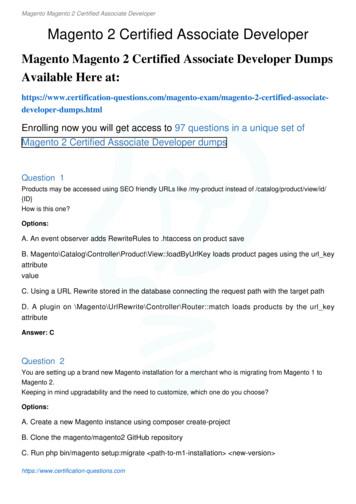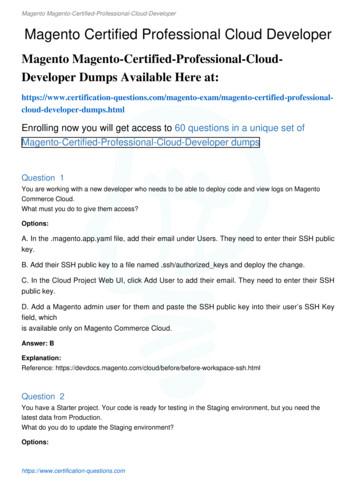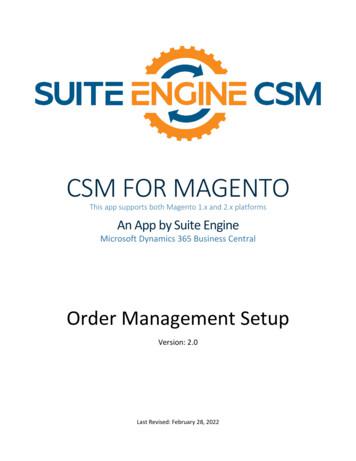Magento Digital Commerce Architecture
MagentoDigitalCommerceArchitecture
Table of Contents1Executive Summary2Functional Overview5Principles of Magento Architecture6Software Architecture11Modularity & Extensions14Themes & gento Ecosystem22Technology Stack25Operations28Security29Conclusion30Getting StartedMAGENTO DIGITAL COMMERCE ARCHITECTURE
Executive SummaryMagento, the leading eCommerce platform built for growing merchantsof all sizes, has been designed from the ground up to be open andextensible, offering limitless flexibility for merchants and developersto create unique and engaging shopping experiences. With a modulararchitecture built on advanced technologies and extended by modernweb APIs and technology extensions, it supports rapid developmentand easy integration with third-party solutions, so you can cost-effectivelyinnovate on your own timeline and keep pace with changing technologiesand customer needs.This paper will take you through the inner workings of the Magento Digital Commerce platform so you cansee how it has been architected for speed, extensibility and scalability. The paper starts with a review ofMagento’s robust core functionality, followed by an in-depth look at its software architecture and frontendtheming capabilities. It then shows how the platform can be easily extended and customized, and reviewsMagento development tools and standards. The paper concludes with a summary of Magento’s powerfulunderlying technologies, security practices, and scalable, high performance design, and provides a quickguide on how to get started with Magento.Let’s get started and see how the Magento platform can transform your business.MAGENTO DIGITAL COMMERCE ARCHITECTURE PAGE 1
Functional OverviewThe functional schematic below displays the components of the Magento Digital Commerce framework,which houses robust out-of-the-box business functionality and advanced capabilities to extend andintegrate the platform with third-party solutions. The following section highlights these componentsand the functionality available with Magento:Desktop BrowserNative AppsMobile BrowserEnterprise ApplicationsFRAMEWORKPRESENTATIONAPI (REST & SOAP)DIGITAL COMMERCEPRODUCT DISCOVERYPRODUCT MANAGEMENTSITE MANAGEMENTProduct BrowsingCatalog ManagementCatalog BrowsingProduct TypesAnalytics & ReportingSearchProduct INGORDER er ManagementShipping & PaymentsUpsell, Cross-Sell, Related ItemsCustomer ServiceTaxVisual MerchandiserCustomer AccountsReturnsCMSNon-Product ContentTHEMESIMPORT / EXPORTEXTENSIONSDATABASE PERSISTENCELANGUAGE PACKWEB SERVICESMESSAGE BUSFIGURE 1: MAGENTO FUNCTIONAL OVERVIEWMAGENTO DIGITAL COMMERCE ARCHITECTURE PAGE 2
Out-of-Box FunctionalityCreating a unique and engaging site is essential to eCommerce success and Magento’s core featureslet you craft powerful shopping and checkout experiences – personalized to a shopper’s onsite behavior,purchase history and buying patterns. You can do this with a rich set of product discovery features,including search and layered navigation, detailed product pages with multiple images and image zoomcapabilities, integrated product reviews and comparisons, and automated cross-sell and upsell features.You can also encourage sales by using customer segmentation tools to target content, coupons, andspecial offers to specific customer groups. And you can build loyalty and encourage more frequentpurchases with reward points, store credits, gift registries, and private sales.Magento ensures shoppers have a consistentexperience no matter how they access your siteby providing a responsive design reference themeyou can leverage to quickly create a seamlessexperience across all devices and channels. Andyou can be sure to convert shoppers to purchasersusing Magento’s streamlined checkout process, withmultiple shipping and payment options and supportfor different currencies, exchange rates and tax rates.A range of management tools give you and your team full control over products, merchandising, and sitecontent. Magento’s product management tools make it easy to add configurable products with supportfor different sizes, colors and other attributes to your store, as well as track inventory levels to make sureyou are never out of stock. Merchandising tools make it fast and efficient to organize product categorypages to maximize sales, and you can use Magento’s content management tool to enrich your shoppingexperience with original content.Magento also lets you efficiently track and process orders, and includes support for return merchandiseauthorization. A customer service interface lets you help shoppers with their purchases, and customeraccount management gives you an in-depth understanding of your most loyal patrons, while alsoenabling faster reordering and checkouts using saved profile information. Finally, you can keep tabson how your business is performing with detailed reports and integrated support for Google Analytics.With such a rich set of features available out of the box, combined with an easy-to-use administrativeuser interface, Magento truly empowers you to create compelling shopping experiences and efficientlymanage operations.MAGENTO DIGITAL COMMERCE ARCHITECTURE PAGE 3
Extending the PlatformOn top of the robust core Magento feature set, you can easily and cost-effectively make customizationsand plug in additional capabilities by adding or replacing extensions with functional modules describedabove, themes that help give your site a unique look and feel, and language packs to localize the site tospecific regions.You can also seamlessly integrate Magento with other third-party solutions such as enterprise resourceplanning (ERP), product information management (PIM), order management (OMS), and contentmanagement (CMS) software using Magento’s extensive and efficient APIs and web services. Full dataimport/export capabilities also make it fast and easy to share product, customer and order informationwith other systems.Magento’s theming inheritance allowsyou to leverage your theming and designcustomizations, making it simple andfast to carry over your design to multiplewebsites, stores, and brands. You can reusecustomizations while quickly and easilydistinguishing separate brands, languages,and locales.With Magento, merchants get a complete suite of eCommerce functionality to build, customize andpromote their site, manage and merchandise product inventory, process orders, track performance,and improve customer engagement and loyalty.MAGENTO DIGITAL COMMERCE ARCHITECTURE PAGE 4
Principles of Magento ArchitectureUnderpinning the rich Magento feature set is a powerful and highlyscalable platform architecture built on the principles introduced below.Each concept is further detailed in the sections of the paper that followthis overview.Layered Product ArchitectureA strongly layered product architecture supports the separation of visual presentation from business logic.This compartmentalization simplifies customization of store appearance and behavior. Architectural layersalso provide programmers with a high-level model for understanding the optimal placement of featuresand code in a complex system. Magento implements the Model-View-Controller (MVC) architectural model.ModularityBuilt to offer limitless flexibility, the Magento platform is built in modules that can be easily added orreplaced. Modules form the basic functional unit and contain the logic to execute required actionsand functions. Modules interconnect with each other to deliver a full range of functionality, and you canextend the core feature set of Magento by writing and incorporating new modules into your installation.Customizable Store BrandingYou can use Magento themes and language packages to create your store’s visual design and languagecapabilities. You can extend and customize the core components of language packages and defaultthemes (using HTML5 and CSS3) to precisely control your site’s behavior and look-and-feel. Unliketemplated SaaS solutions, Magento offers the highest level of flexibility in customizing your site to yourunique needs. Further, Magento’s native theme inheritance capabilities allow you to efficiently reusetheming and design customizations to differentiate separate brands, stores and locales without spendingadditional time or budget.External IntegrationsService contracts in the Magento framework provide a way to access public API endpoints to supportthe extensibility of Magento and its integration with third-party systems. These PHP interfaces to modulesstreamline the use of APIs.Open Source TechnologiesThe Magento tech stack includes popular open source technologies such as Linux OS, Apache/Nginxserver, MySQL, Zend, and Composer, offering a robust toolset for deploying large, distributed storefrontsand for customizing the product for your particular needs.MAGENTO DIGITAL COMMERCE ARCHITECTURE PAGE 5
Software ArchitectureAt its highest level, Magento’s product architecture consists of the core product code plus optional modulesthat can be added to enhance or replace the basic product code. Both the optional modules and the coreMagento product code are organized into layers.The Magento software architecture follows standard application layering, with the separation of visualpresentation code from business logic (within the domain layer) through the service layer. The service layerdefines standard APIs and interfaces for visual presentation code to access business logic. This improvescode extensibility and maintainability, while also simplifying backwards compatibility after upgrades.OOP Architecture and Programming PrinciplesObject-Oriented Programming (OOP) principles are inherent in Magento’s design, which allow formaximum flexibility and extensibility of software components, permitting you to design and implementhighly customized websites. The advantages of OOP principles include incorporation of industry-standardprogramming design patterns and the strict separation of business logic from the presentation layer.The following diagram illustrates the main components of Magento. It shows the internal layers andenclosing Magento framework, plus primary external interaction points.Desktop BrowserNative AppsMobile BrowserEnterprise ApplicationsFRAMEWORKPRESENTATIONAPI (REST & SOAP)MODULEPRESENTATION LAYERHTML / CSS /JavaScriptPage CompositionControllersWeb APIEndpointsSERVICE LAYERService InterfacesData InterfacesModelsResource ModelsDOMAIN LAYERIMPORT / EXPORTDATABASE PERSISTENCEWEB SERVICESMESSAGE BUSFIGURE 2: MAGENTO SOFTWARE ARCHITECTURE & APPLICATION LAYERINGMAGENTO DIGITAL COMMERCE ARCHITECTURE PAGE 6
Presentation LayerWhen you interact with the Magento web interface, you are working directly with presentation layer code.The presentation layer contains both: View elements, which include HTML/CSS/JavaScript web page assets, and the pagecomposition concepts of layouts, blocks, and templates; and Controllers, which process commands to and from the user interface.You can extensively customize the user interface by using themes to modify the CSS and HTML templatefiles of the presentation layer.Magento separates presentation layer concepts from business logic, simplifying the customization ofa Magento installation’s appearance. Separation also simplifies the job of extension developers, as nobusiness logic concepts are buried in presentation files.HTML / CSS / JavaScriptMagento is HTML5 and CSS3 compliant out of the box. All base themes are responsive by default,enabling your site to be optimized for mobile, tablet, and desktop browser access. All HTML, CSS, andJavaScript web page assets are stored separately, allowing easier customization of a site. Magento alsosupplies tools for automatic optimization strategies such as CSS and JavaScript minification for fasterpage load times and improved site performance.Page CompositionPage composition (the “View” in MVC) is controlled by layout files that assemble blocks, containers,and UI components into a page for display by a web browser. Blocks are backed by PHP code to generatedynamic page content. They are typically paired with easily customizable PHTML template files togenerate fragments of HTML that are assembled into the page.ControllersControllers (again from MVC) control page flows and the orchestration of form submission. Magento followsthe standard MVC pattern, providing good separation of concerns to achieve enhanced modularity.MAGENTO DIGITAL COMMERCE ARCHITECTURE PAGE 7
Web API EndpointsMagento also exposes core eCommerce functionality via web services as both RESTful and SOAPservices. This ensures that all core functionality available to end users is equally available to externalsystems such as ERP, PIM, and OMS systems. In today’s highly interconnected world, this is increasinglyessential and ensures that Magento is ready to support current trends such as “buy buttons” integratedto social platforms (like Facebook, Twitter, Pinterest etc.) for in-app purchases, and in the future, Internetof Things (IoT) devices with automatic reordering.Enhanced integrations to external systems also require support of additional authentication schemes.The Magento framework supports multiple Web API authentication schemes for different use cases, suchas AJAX requests directly from a user’s browser (where an external user is already authenticated) or fromnative mobile applications (where the user can be asked for credentials), and for system integration withother backend systems such as ERP systems (where there is no user present to provide credentials).As well as supporting standard services, Magento simplifies the development of your own services. If theservice you need is not available, just create a new one. Simply write your own “service contract” as PHPinterfaces and define binding rules from URLs to your PHP code, and your new web service is available for use.Desktop BrowserNative AppsMobile BrowserEnterprise ApplicationsFRAMEWORKPRESENTATIONAPI (REST & SOAP)MODULEPRESENTATION LAYERHTML / CSS /JavaScriptPage CompositionControllersWeb APIEndpointsSERVICE LAYERService InterfacesData InterfacesModelsResource ModelsDOMAIN LAYERIMPORT / EXPORTDATABASE PERSISTENCEWEB SERVICESMESSAGE BUSFIGURE 3: WEB API ENDPOINTSMAGENTO DIGITAL COMMERCE ARCHITECTURE PAGE 8
Service LayerThe service layer is a thin architectural layer that provides a bridge between the presentation layer andthe domain layer of business logic and resource-specific data. It holds the definition of “service contracts”(stable PHP APIs defined using PHP interfaces) for use by presentation code, Web API endpoints, andother modules. By using interfaces, different implementations of a service contract can be swapped bya module (perhaps from an extension purchased on the Magento Marketplace) without impacting otherparts of the system. Service contracts result in great API stability and isolation of code, further improvingextensibility and simplifying the upgrade process.Service contracts are defined as a set of: Service Interfaces that provide the main entry point functions, and Data Interfaces that provide access.A set of related service interfaces and data interfaces form a single service contract.Domain LayerThe domain layer holds the business logic that powers a site and adds a significant advantage insimplifying the customization of a Magento installation’s appearance. This layer includes service contractimplementations for eCommerce functionality (also easily exposed as Web APIs), domain modelscontaining business logic, and database persistence. Models (from the MVC pattern) hold the business logic. Resource Models are responsible for database interaction, such as for persisting productdata or customer data.Database PersistenceAs described in the previous section, the domain layer deals with business logic, including – crucially– merchant business data that represents products and related attributes, customers, orders, tax andshipping rates, and basically all the stored information on which your store’s transactions are based.Thus, how efficiently and securely your data is stored and then accessed determines your store’s abilityto convert orders and process sales.And true to its open source roots, Magento leverages the popular open source MySQL database systemfor storing and accessing your business data.MAGENTO DIGITAL COMMERCE ARCHITECTURE PAGE 9
For flexibility, the Magento database schema heavily utilizes an Entity-Attribute-Value (EAV) data model.Compared to traditional relational tables, EAV tables give the flexibility of adding unlimited attributesfor products, categories, customers, and so on, at any point of the project, without requiring databaseschema changes.Magento also supports separate database instances to be spun out for product information, orders, andcheckout. This delivers great checkout performance, critical to improving sales and conversions, even if therest of the system is more heavily loaded. With the proper configuration and hardware, Magento can scaleto support customers with 3.5 million page views/hour for catalog and 250,000 orders/hour on orders.For larger merchants, there are a number of MySQL drop-in replacement database technologies, suchas MySQL Cluster for high throughput or high availability sites.Desktop BrowserNative AppsMobile BrowserEnterprise ApplicationsFRAMEWORKPRESENTATIONAPI (REST & SOAP)DIGITAL COMMERCEIMPORT / EXPORTDATABASE PERSISTENCEMASTER DB(MAIN)SLAVE DB(MAIN)SLAVE DB(CHECKOUT)MASTER DB(CHECKOUT)SLAVE DB(OMS)WEB SERVICESMESSAGE BUSMASTER DB(OMS)SLAVE DB(CATALOG)SLAVE DB(WISHLIST)FIGURE 4: MAGENTO DATABASE TECHNOLOGYMAGENTO DIGITAL COMMERCE ARCHITECTURE PAGE 10
Modularity & ExtensionsMagento is a highly modular platform, constructing sites from a series of interlocking components.Maximizing extensibility has been the goal through all aspects of Magento development. Merchantscan expand their storefront features by adding new or replacing existing modules with third-party orcustom-created modules. For example, core tasks such as shipping are packaged as discrete modules,which means you can easily add or delete shipping providers by simply adding or deleting modules.The product framework provides common logic to control routing and other core application functions.The Magento framework also provides a set of core logic: PHP code, libraries, and the base conceptsleveraged by modules and other components.ComponentsWithin Magento there are three types of modular components: modules, which provide business logic;themes, which change the look and feel of a site; and language packages, which are needed to translatea site for internationalization. Modules and themes are the core units of customization in Magento andboth have a lifecycle allowing them to be installed, deleted, and disabled. Theme inheritance with Magentoimproves reuse of code, thus increasing speed, making it easier to maintain while reducing cost ofcustomization. Extensions available on Magento Marketplace are groups of modules sold as a single bundle.Going deeper, modules encapsulate a particular business feature or set of features and function as apackage of code. They include both the business logic that implements new features and the default userinterface for those features, whichcan be customized by themes.Desktop BrowserNative AppsMobile BrowserEnterprise ApplicationsThey also contain a set of blocks,FRAMEWORKcontrollers, models, and more.Modules can relate to and dependPRESENTATIONAPI (REST & SOAP)on each other in a variety of ways,MODULEbut should be as independent asPRESENTATION LAYERpossible to maximize flexibility whencustomizing a site.MODULE AMODULE BMODULE CMODULE DMODULE ESERVICE LAYERDOMAIN LAYERIMPORT / EXPORTDATABASE PERSISTENCEWEB SERVICESMESSAGE BUSThe Magento architecture ensuresthat
OOP Architecture and Programming Principles Object-Oriented Programming (OOP) principles are inherent in Magento’s design, which allow for maximum flexibility and extensibility of software components, permitting you to design and implement highly customized websites. The advantages of OOP principles include incorporation of industry-standard
Magento 2 Worldpay for Business User Guide by Meetanshi Author: Meetanshi Keywords: Magento 2 Worldpay Payment, Magento 2 Worldpay Payment Gateway Integration, Magento 2 Worldpay Payment Module, Magento 2 Extension, Magento 2, magento 2 worldpay for business, magento 2 worldpay business, worldpay business module for magento 2 Created Date
magento survey magento feedback extension magento survey extension magento feedback magento feedback form magento quiz magento poll extension magento customer feedback magento customer feedback extension magento feedback
A. Create a new Magento instance using composer create-project B. Clone the magento/magento2 GitHub repository C. Run php bin/magento setup:migrate path-to-m1-installation new-version Magento Magento 2 Certified Associate Developer https://www.certification-questions.com
Magento Commerce Magento Commerce Cloud Beginning at 40,000 annually Yes Drag-and-drop page builder with Bluefoot CMS Magento is an enterprise eCommerce software that offers both free (open source) and proprietary licensing models. Magento Inc., and its enterprise platform, Magento Commerce, was recently acquired by
Magento-Certified-Professional-Cloud-Developer dumps Question 1 You are working with a new developer who needs to be able to deploy code and view logs on Magento Commerce Cloud. What must you do to give them access? Options: A. In the .magento.app.yaml file, add their email under Users. They need to enter their SSH public key.
This is the Magento Soap/xml-RPC user that CSM should authenticate its API Calls with. See below example Magento screen shot. This user should be assigned a Magento user roll that gives it access to all API’s. Use the Soap/xml-RPC User you setup on Magento API Key This is the Magento S
recommended that you consider upgrading your Magento 1 environment to Magento 2. For more information on the differences between Magento 1 and Magento 2 , please see . here. CSM Initial Setup Manage the Magento for CSM Extension CSM requires a setting to allow it to initiate communication to Mage
Urgent Action Required - Magento 1 Unsupported after June 2020 When Magento announced the release of Magento 2 in November 2015, merchants and developers alike were made aware that Magento 1 would become obsolete. The original end date for support of Magento 1 was November 2018, however, this was revised to June 2020






















